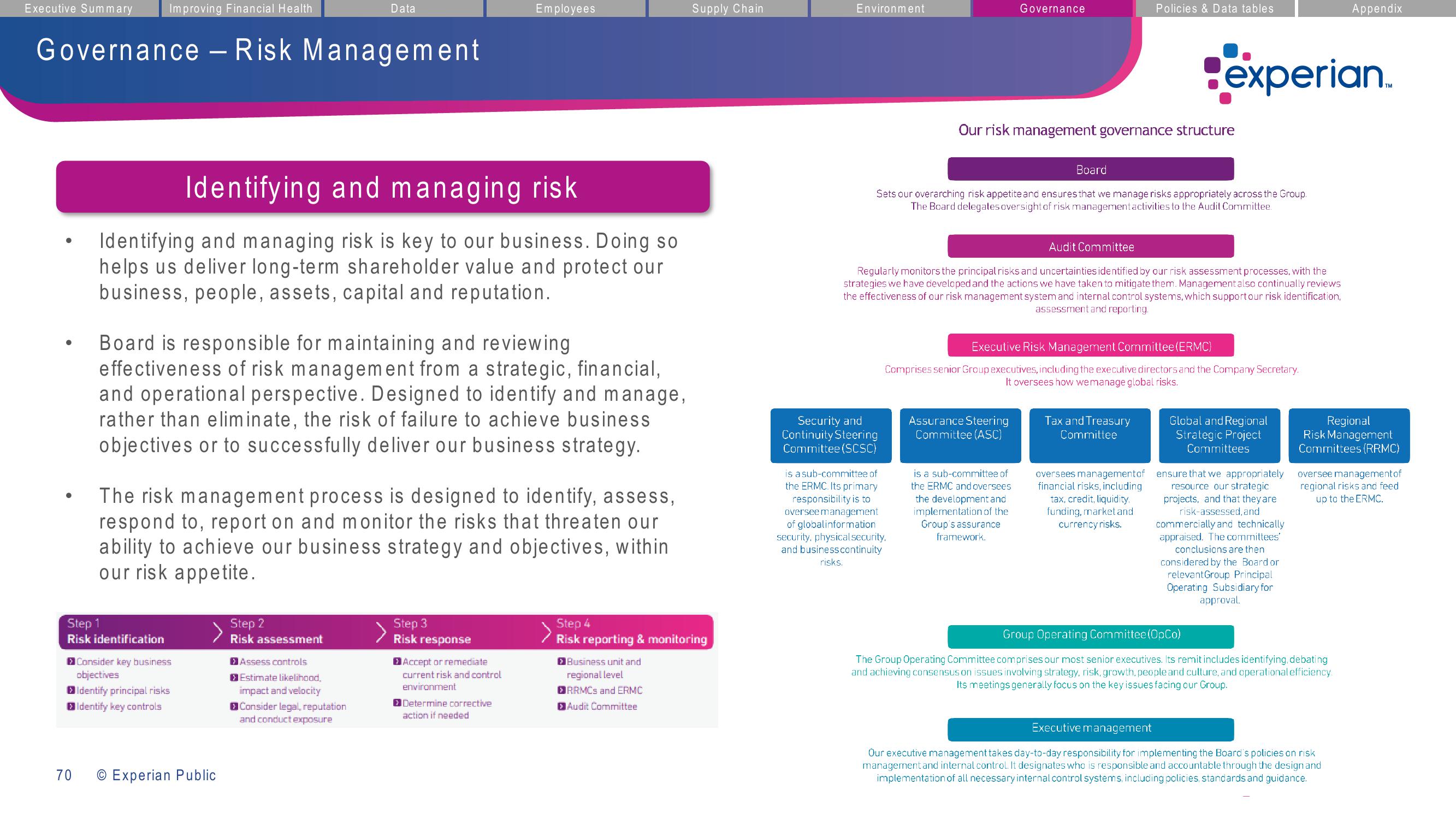Experian ESG Presentation Deck
Executive Summary
Governance
●
●
●
Improving Financial Health
70
Step 1
Risk identification
-
Identifying and managing risk
Identifying and managing risk is key to our business. Doing so
helps us deliver long-term shareholder value and protect our
business, people, assets, capital and reputation.
Consider key business
objectives
Identify principal risks
Identify key controls
Risk Management
Board is responsible for maintaining and reviewing
effectiveness of risk management from a strategic, financial,
and operational perspective. Designed to identify and manage,
rather than eliminate, the risk of failure to achieve business
objectives or to successfully deliver our business strategy.
Data
The risk management process is designed to identify, assess,
respond to, report on and monitor the risks that threaten our
ability to achieve our business strategy and objectives, within
our risk appetite.
O Experian Public
Step 2
Risk assessment
Assess controls
> Estimate likelihood,
impact and velocity
Consider legal, reputation
and conduct exposure
Employees
Step 3
Risk response
Accept or remediate
current risk and control
environment
Determine corrective
action if needed
Supply Chain
Step 4
Risk reporting & monitoring
Business unit and
regional level
DRRMCS and ERMC
>Audit Committee
Environment
Security and
Continuity Steering
Committee (SCSC)
Governance
Board
Sets our overarching risk appetite and ensures that we manage risks appropriately across the Group.
The Board delegates oversight of risk management activities to the Audit Committee.
is a sub-committee of
the ERMC. Its primary
responsibility is to
oversee management
of globalinformation
security, physical security,
and business continuity
risks.
Our risk management governance structure
Audit Committee
Regularly monitors the principal risks and uncertainties identified by our risk assessment processes, with the
strategies we have developed and the actions we have taken to mitigate them. Management also continually reviews
the effectiveness of our risk management system and internal control systems, which support our risk identification,
assessment and reporting.
Assurance Steering
Committee (ASC)
Policies & Data tables
Executive Risk Management Committee (ERMC)
Comprises senior Group executives, including the executive directors and the Company Secretary.
It oversees how we manage global risks.
is a sub-committee of
the ERMC and oversees
the development and
implementation of the
Group's assurance
framework.
experian
Tax and Treasury
Committee
oversees management of
financial risks, including
tax, credit, liquidity.
funding, market and
currency risks.
Global and Regional
Strategic Project
Committees
ensure that we appropriately
resource our strategic
projects, and that they are
risk-assessed, and
commercially and technically
appraised. The committees
conclusions are then
considered by the Board or
relevant Group Principal
Operating Subsidiary for
approval.
Appendix
Regional
Risk Management
Committees (RRMC)
Group Operating Committee (OpCo)
The Group Operating Committee comprises our most senior executives. Its remit includes identifying, debating
and achieving consensus on issues involving strategy, risk, growth, people and culture, and operational efficiency.
Its meetings generally focus on the key issues facing our Group.
TM
oversee management of
regional risks and feed
up to the ERMC.
Executive management
Our executive management takes day-to-day responsibility for implementing the Board's policies on risk
management and internal control. It designates who is responsible and accountable through the design and
implementation of all necessary internal control systems, including policies, standards and guidance.View entire presentation